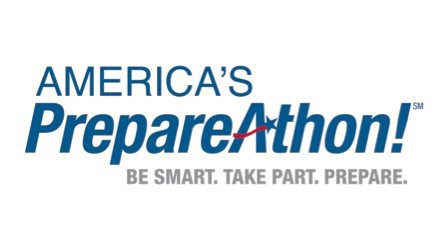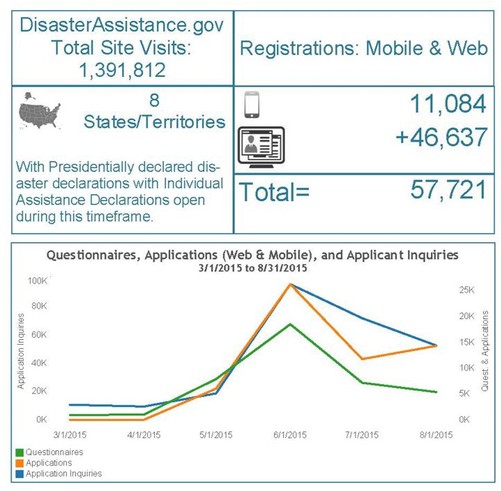DisasterAssistance.gov is the official website devoted to
helping disaster survivors. It’s a portal to help survivors locate more than
70 forms of assistance across 17 federal agencies via the internet using
their desktop computer, tablet or mobile device. Using prescreening
technology, DisasterAssistance.gov offers an anonymous questionnaire that
generates a personalized list of assistance a survivor can apply for based on
the answers. The site also provides other disaster-related information and
resources to help before, during and after a disaster.
FEMA Encourages
Families and Communities to Participate in National PrepareAthon! Day
Today, the Federal Emergency Management Agency (FEMA) is
encouraging individuals, families, workplaces, schools, and organizations
across the nation to take part in National PrepareAthon! Day on September
30th, 2015. Extreme weather is occurring more often across the United States,
which is increasing the costs of natural disasters. According to a recent
survey conducted by FEMA, fewer than half of Americans have discussed and
developed an emergency plan with their household.
As part of National Preparedness Month and National
PrepareAthon! Day, FEMA is encouraging everyone to develop and practice their
family emergency plan to prepare for disasters that are known threats in
their communities.
“The first step in preparing yourself and your family is
learning the type of disasters that can happen where you live,” said FEMA
Administrator Craig Fugate. “Your family may not be together when disaster
strikes. Developing an emergency communication plan doesn’t cost a thing, and
the time you’ve invested beforehand will make it easier for your family to
reconnect.”
National PrepareAthon! Day is part of America’s PrepareAthon!,
a nationwide grassroots campaign for action to increase community
preparedness and resilience through hazard-specific group discussions, drills,
and exercises. The campaign offers easy-to-implement preparedness guides,
checklists, and resources to help individuals, organizations, and communities
prepare for the types of disasters that are relevant to their area. People
can take these simple steps to increase their preparedness:
USDA and FEMA
Partner on Summer Program
USDA STEM Camp
partcipants make their presentations.
FEMA
DAIP is not only a critical managing partner for the USDA on Disaster
Assistance. FEMA also supported another USDA initiative, the Open Data
Science Technology Engineering and Math (STEM) camp by providing USDA with
valuable educational materials for the open data STEM camp focused on
agriculture. FEMA’s Are You
Ready disaster guidebooks were
distributed to the students and used in their training as a key resource.
USDA is committed to providing USDA open data to federal,
state, local, tribal, industry, academia, and the public to foster
innovation, economic growth and improve American lives. The USDA Open Data
initiative is referred to as OpenAg. To fulfill its mission, USDA must be
positioned to provide outstanding services to its internal and external
customers by recruiting, training, and retaining a world-class IT workforce
that is flexible enough to meet rapidly changing business needs. Because
information technology (IT) directly supports that mission, USDA needs to
develop individuals with leadership competencies and a variety
of emerging IT skill sets to continue its role as a dynamic organization
capable of strengthening the American agricultural economy and building
vibrant rural communities.
As a result, USDA partnered with GovLab/New York University
and the Patriots Technology Training Center on this first of its kind Open
Data STEM Summer camp.
USDA is tasked with providing national leadership on food, agriculture,
natural resources, rural development, nutrition, and related issues. To
support the USDA’s mission, the GovLab Academy designed and executed a dual
pilot of a two-week open data summer program for Washington, DC-area
teenagers. The goal of the camp is to help the leaders of tomorrow learn more
about data, the tools of data science, and the ways they might be leveraged
to improve innovation and security in the nation’s food supply and forest
service. The camp provided an opportunity for USDA employees to support the
goal of strengthening STEM education in this country by piloting an
initiative that can be scaled and replicated across agencies and across
levels of government.
Using data provided by the USDA agencies the camp participants
worked on small, actionable projects linked to one or more key issues facing
the USDA, in which teams of students had to find, qualify, and interpret
relevant data, and then they were asked to create and present a compelling
visualization of the data they have found and of its significance. The second
group of students graduated on Friday, July 31st.
USDA thanks FEMA-DAIP for their continued support both
as a managing partner, as well as supporting other initiatives, including the
Open Data STEM summer camp.
DisasterAssistance.gov
Site Metrics Fiscal Year (FY) through August 31, 2015
|
Tuesday, September 29, 2015
Subscribe to:
Post Comments (Atom)



No comments:
Post a Comment